Jefferson Davis Historic Site, Irwinville, Georgia
I’ve just driven into the tiny hamlet of Irwinville, Georgia, aka Nowheresville, looking for the Jefferson Davis Memorial as it’s described on the official state map. What you might ask, has caused me to leave the relative sameness, safety and comfort of I-75 for the unknown backroads of rural Georgia? Isn’t that what the guys in Deliverance did? Also, what if you run into a bunch of walkers? After all The Walking Dead does take place in Georgia. Well, here’s why.
Anyone who knows me, know I love maps and never fail to stop each time I cross a state line to pick up the latest state map at the Welcome Center. So I did that and started poring over it like a favourite book. First thing I notice is smiling Governor Nathan Deal on the back cover who welcomes people to the state with this phrase, “Thank you for keeping Georgia on my mind!‘ Ignoring the grammatical impossibility of this – I don’t even know the guy, I can’t help but think he’s right. It was only yesterday that Governor Deal had to veto a bill that was so obviously anti- LGBT that it had Georgia on a lot of people’s minds.
Turning to the map itself I look for anything unusual that’s not that far off the I-75 corridor and come across a black square with the words Jefferson Davis Memorial. Mmm, that’s interesting. I knew that Jefferson Davis, the President of the Confederate States of America, had associations with Kentucky (born there, like Lincoln), Virginia (Richmond was the capital of the Confederacy) and Mississippi (had his cotton plantation and slaves there), but Georgia? So without hesitation I left the I-75 somewhere south of Macon and hit the back roads.
As I approach Irwinville, the place closest to the Jefferson Davis Memorial, I cannot help but notice that confederate flags are displayed quite prominently in many yards. In the last house before the memorial the windows have confederate flags instead of drapes. There seems to be a direct correlation between the type of property and the likelihood of it having one of these flags; generally the shabbier and more run down they are, the more likely to have a rebel flag. Well to do houses with well kept yards tend to have American flags.
Jefferson Davis Historic Site
Pulling up to the white columned building I notice that I am the only car in the parking lot other than one I presume belongs to the person running the place. This is the museum building.
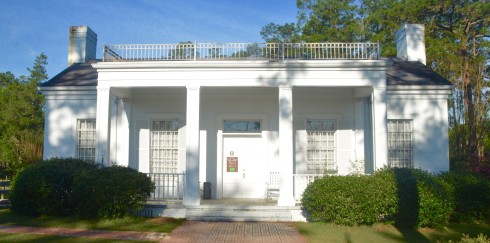
Outside is this plaque with its rather startling version of the events that happened here just over 150 years ago. In case the print is too small for you to read it describes the capture of the fugitive Jefferson Davis at this very spot. OK, so now I know why it’s important. However, the objectivity of the retelling of the story leaves something to be desired. He is described as being “undaunted by the tragic surrenders at Appomattox and Durham Bridge“. I doubt if you were a starving member of Lee’s Army of Northern Virginia that you thought surviving the war that had cost over 600,000 lives was all that tragic. It goes on to tell how Jefferson Davis hoped to hook up with existing armies further west and continue the fight from there until the north agreed to ‘guarantee the security of person and property‘. The property meaning of course, the slaves. Finally it describes how ‘the revered leader of the Lost Cause‘ was captured and taken away to a military prison. ‘Revered leader’ sounds surprisingly akin to the ‘Dear leader’ of a certain Asian nation.
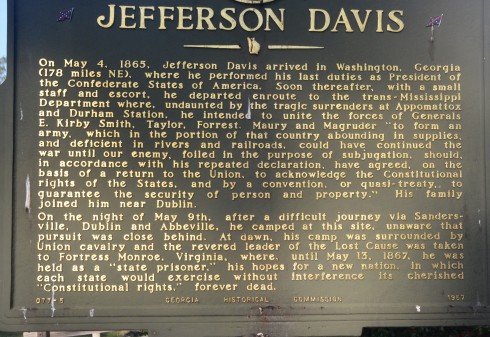
Inside, the museum is basically one large room with the state flags of the various confederate states encircling the walls. That’s Tennessee, North Carolina and Georgia in this picture.
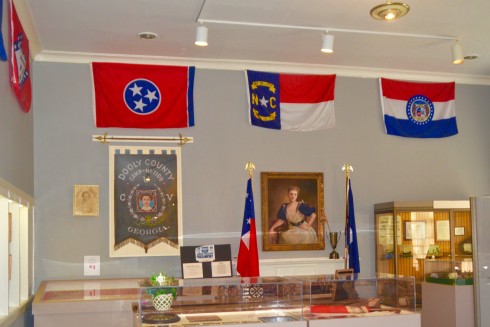
Sure enough I am the only visitor and after paying the $4.00 admission fee the fellow in charge asks me if I want to see an 18 minute video on the capture of Jefferson Davis. This turns out to be far more informative than the plaque and basically describes Jefferson Davis as a fugitive rather than anyone who could seriously continue a war against the overwhelming armies of General Grant. Most people think the civil war ended at Appomattox Court House, but actually it didn’t. While Jefferson Davis, as legal head of the Confederate States, was on the loose the war was still technically going. It would be like if Hitler had escaped his bunker and was intent on carrying on the war, regardless of how hopeless it was.
The Hitler analogy is not far off, because while on the run, Lincoln was assassinated and Davis was automatically suspect. There was a $100,000.00 bounty on his head. People were so eager to cash in that when two groups of Union soldiers had Davis tracked down to this very site, they starting shooting at each other and two were killed. Imagine being the mother of one of those boys and learning that they were the last people killed in the war and it was by that most oxymoronic of terms ‘friendly fire’. The video also debunks the myth that Jefferson Davis tried to escape by donning women’s clothing.
Looking around the museum afterward was quite interesting. There is this portrait of Jefferson Davis.
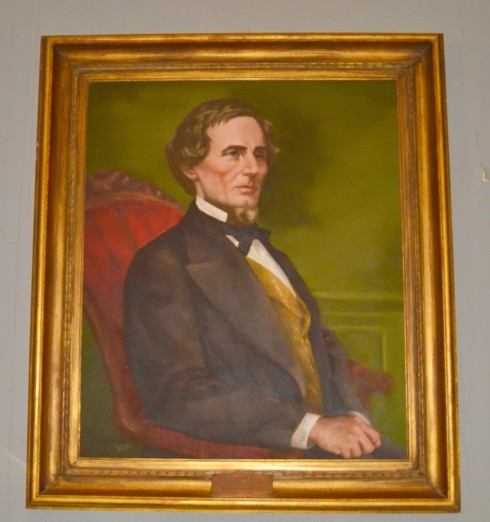
And right beside it this trophy.
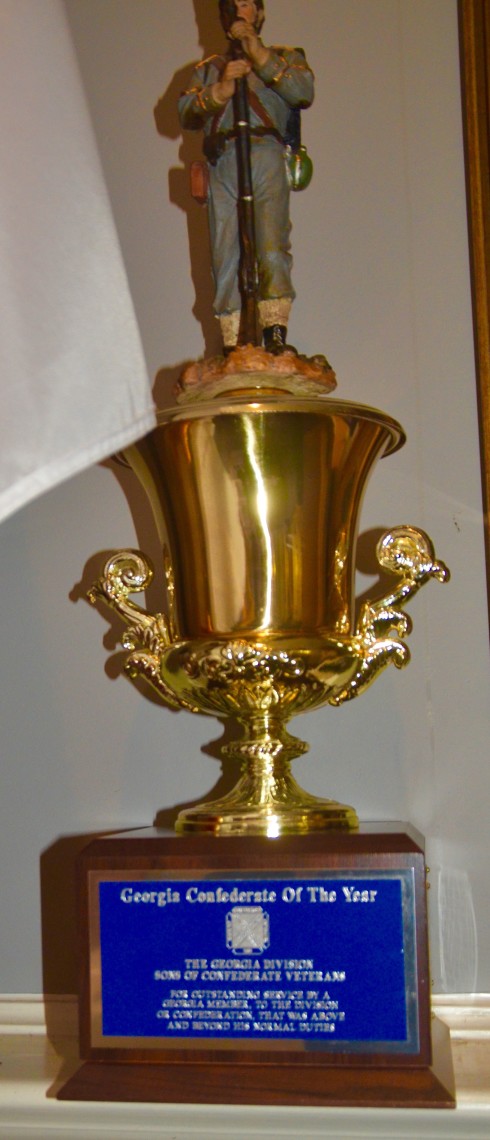
Yes it’s awarded to the Georgia Confederate of the Year. I have no idea what you have to do to earn this. Maybe be the best accomplice at a bank robbery or some type of flimflam scheme?
And they still sell little confederate flags.

Outside there is this bust of Jefferson Davis which shows the man staring straight ahead in a determined look that tells you he would do it all over again if he could. After all, he was fighting for his ‘property’, right?
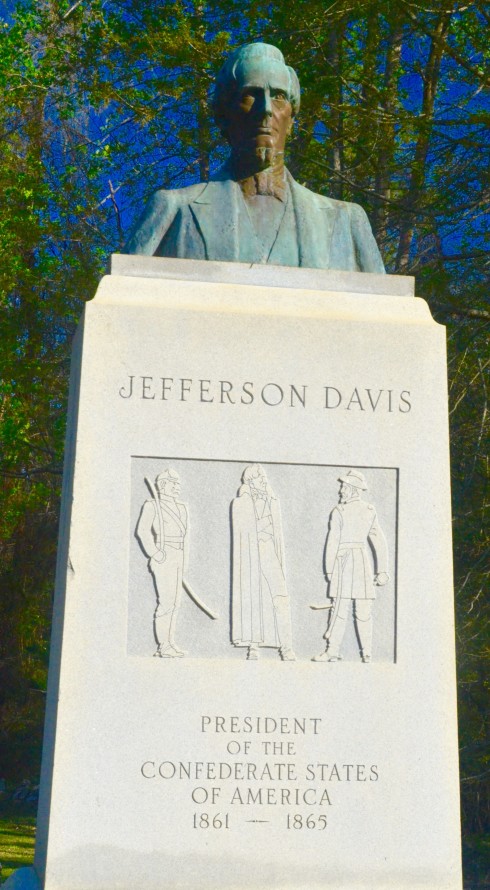
After the war Davis did not get the treatment many in the north thought he deserved and they failed to ‘hang Jeff Davis from a sour apple tree’ as was promised in John Brown’s Body. He did have his citizenship stripped from him, but Georgian Jimmy Carter restored it in 1978, one of the more useful acts of his otherwise forgetful Presidency. Davis died in 1889, outliving his nemesis Abraham Lincoln by almost twenty-five years.
Tomorrow I’ll cross into Florida where I’ll be stopping at Kissimmee Prairie Preserve State Park to see where the last wild Carolina parakeet was shot and to do a little biking. Please join me.

